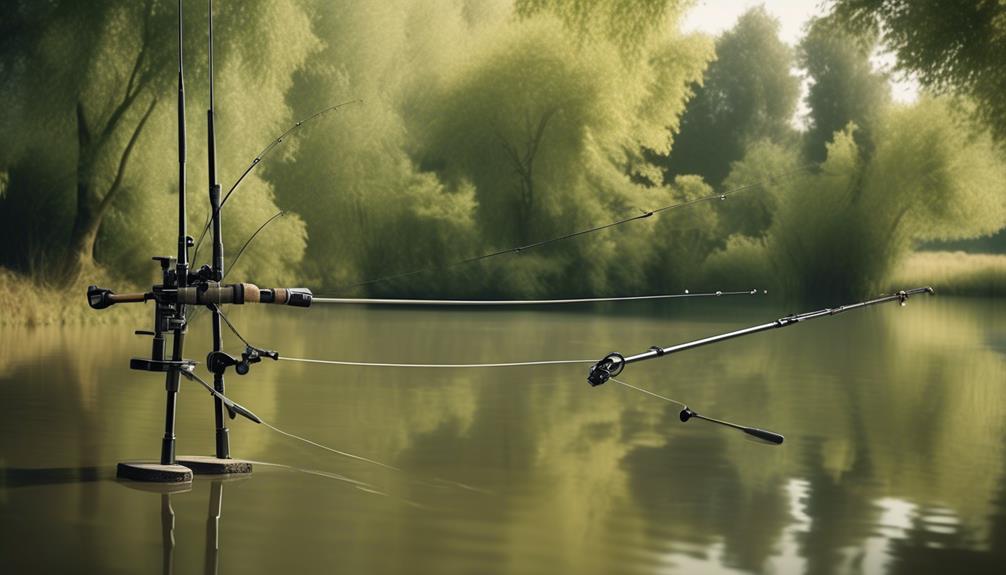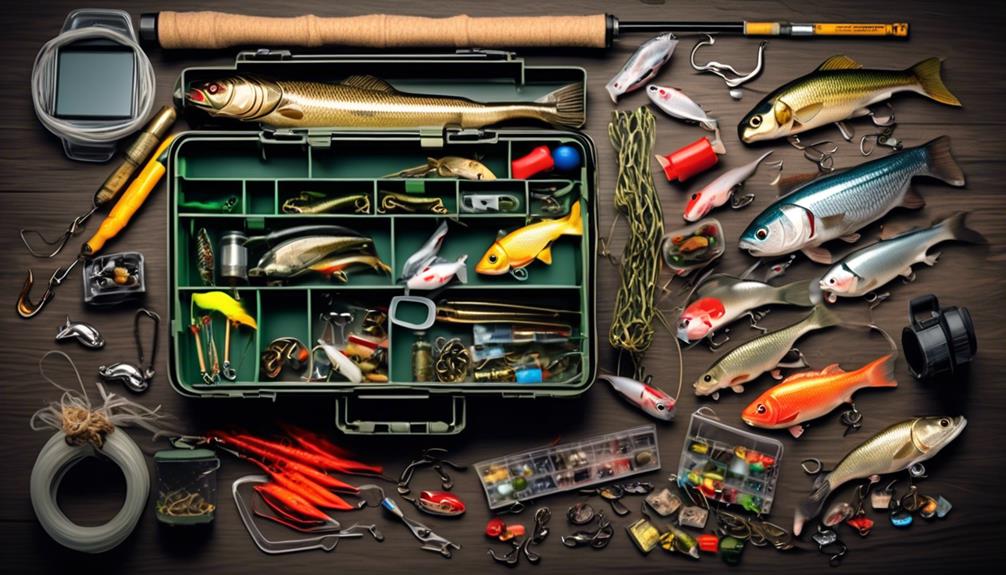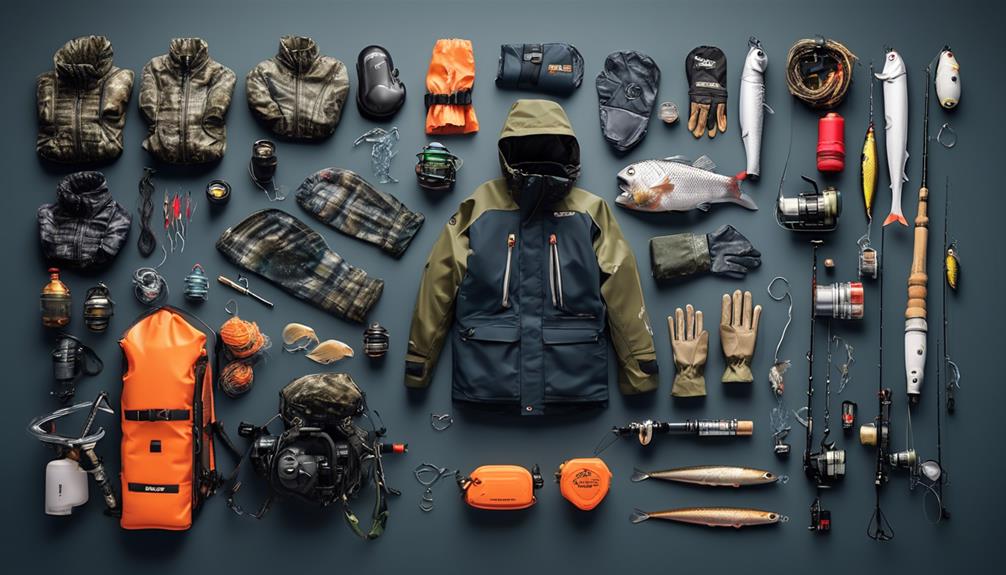So, you've decided to take on the challenge of carp fishing and you're ready to gear up for the adventure. As you stand at the edge of the water, you'll quickly realize that having the right equipment is crucial for a successful and satisfying fishing experience.
But where do you start? Well, there are seven essential pieces of tackle and gear that will significantly improve your chances of landing those elusive carp. From rods and reels to bite alarms and landing nets, each item plays a pivotal role in your pursuit of these wily fish.
But what are they, and how do they contribute to your angling success?
Rods and Reels
When selecting carp fishing tackle, choosing the right rods and reels is crucial for a successful fishing experience. Proper rod maintenance and reel care are essential to ensure that your equipment performs at its best.
Regularly clean your rods to prevent dirt and debris from affecting their performance. Inspect the guides for any signs of damage and replace them if necessary. Additionally, lubricate the reel components to keep them functioning smoothly and extend their lifespan.
Mastering casting techniques and retrieval methods is equally important. Practice different casting styles to improve your accuracy and distance. Pay attention to the timing of your release and the trajectory of your cast to target specific areas where carp are likely to be feeding.
Experiment with various retrieval methods such as steady retrieves, stop-and-go retrieves, and twitching to determine what entices carp to bite. Understanding how to manipulate your bait or lure through different retrieval techniques can significantly increase your chances of a successful catch.
Bait and Baiting Equipment
To enhance your carp fishing experience, selecting the right bait and baiting equipment is crucial for attracting and enticing the carp. Here are some essential tips to help you make the most of your bait and baiting equipment:
- Bait Selection: When it comes to carp fishing, the right bait can make all the difference. Carp are known to be attracted to a variety of baits, including boilies, corn, and pellets. Boilies, in particular, are a popular choice due to their ability to stay intact for extended periods underwater, releasing attractive scents and flavors that entice carp. Additionally, experimenting with different flavors and scents can help you determine what works best in your fishing spot.
- Baiting Techniques: Utilizing PVA bags can be an effective baiting technique when carp fishing. PVA bags are porous and dissolve in water, releasing the bait within and creating a concentrated area of attraction around your hook bait. This method can be particularly useful when fishing at longer distances or in weedy areas, where it's essential to ensure your bait reaches the targeted area effectively.
- Maintaining Consistency: Regardless of the bait and baiting techniques you choose, consistency is key. Carp can be cautious creatures, and maintaining a consistent feeding pattern can help build their confidence in your bait, leading to more successful catches.
Line and Hooks
Selecting the right line and hooks is essential for maximizing the effectiveness of your bait and baiting techniques in carp fishing. When it comes to line strength, it's crucial to match the line to the size of the carp you're targeting. For smaller carp, a line strength of 10-12lbs should suffice, while larger carp may require a line strength of 15-20lbs to handle their weight and power.
Additionally, choosing the right hook size is equally important. For average-sized carp, a hook size ranging from 6 to 10 should work well, but for larger specimens, you may need to opt for hook sizes between 2 and 4 to ensure they can handle the fish's size and strength.
In carp fishing, mastering the art of knot tying is paramount. The knot used to attach the hook to the line should be strong and reliable to prevent breakages during the fight with a carp. The improved clinch knot and palomar knot are popular choices for securing hooks to the line.
Furthermore, refining your casting techniques can significantly impact the success of your carp fishing endeavors. Practicing accurate casting to specific spots where carp are likely to feed can greatly increase your chances of a successful catch.
Carp Rigs
You can enhance your carp fishing success by mastering various carp rig setups that cater to different fishing conditions and bait presentations. Carp rigs play a crucial role in determining your success in catching carp. Here are some key aspects to consider for rig efficiency and knot tying:
- Rig Efficiency
When setting up your carp rig, consider the fishing conditions and the behavior of the carp. For instance, in weedy or snaggy areas, using a helicopter rig can be more efficient as it helps to present the bait above the debris. On the other hand, in clear and open waters, a simple inline rig might be more effective. Understanding the right rig for the conditions can significantly improve your chances of a successful catch.
- Knot Tying
The strength and reliability of your knots are paramount in carp fishing. Mastering essential knots such as the knotless knot for hair rigs, the blood knot for connecting leaders, and the grinner knot for attaching the mainline to swivels is crucial. A weak knot can lead to losing the fish of a lifetime, so investing time in perfecting your knot tying skills is essential.
- Adjusting and Adapting
Being able to adjust and adapt your carp rigs on the spot can make a significant difference. Whether it's changing the hook size, altering the length of the rig, or adjusting the weight, being able to adapt to the fishing conditions can greatly increase your chances of success.
Mastering carp rigs and understanding rig efficiency and knot tying can elevate your carp fishing game and lead to more rewarding angling experiences.
Bite Alarms
How can bite alarms enhance your carp fishing experience and increase your chances of a successful catch?
Well, bite alarm technology has seen significant advancements in recent years, making it an indispensable tool for carp anglers. These nifty gadgets are designed to alert you when a fish takes the bait, allowing you to respond quickly and effectively. By using bite alarms, you can significantly improve your strike rate and maximize your fishing opportunities.
One of the key features of modern bite alarms is their sensitivity adjustment. This allows you to fine-tune the alarms to detect even the slightest movements or pickups by cautious carp. Whether you prefer a more delicate touch or a higher sensitivity setting, being able to adjust the sensitivity of your bite alarms can make a substantial difference in your fishing success. Additionally, some advanced bite alarms offer adjustable tone and volume settings, allowing you to customize the alerts to suit your preferences and fishing environment.
Moreover, the integration of wireless technology in bite alarms has revolutionized the way anglers monitor their lines. With wireless bite alarms, you can receive alerts directly to your receiver, giving you the freedom to move around your swim without missing any action. This level of convenience and flexibility can make your carp fishing experience more enjoyable and productive.
Landing Nets
When choosing a landing net for carp fishing, consider the material, size, and handle design to ensure efficient and safe fish retrieval. Landing nets are essential tools for safely landing and handling carp, and selecting the right one can greatly enhance your fishing experience. Here's what you need to know about landing nets:
- Types of Landing Nets: Landing nets come in various types, including triangular, oval, and spreader block nets. Each type has its own benefits, and the choice depends on your personal preference and fishing style.
- Benefits of Landing Nets: Landing nets help reduce stress on the fish, making it easier to handle and release them. Additionally, they prevent potential injury to both the fish and the angler, ensuring a humane and safe fishing experience.
- Proper Handling Techniques: When using a landing net, it's crucial to handle the fish with care. Always support the fish's weight with both hands and avoid lifting it too far from the ground to prevent any harm.
When it comes to choosing a landing net, popular brands like Fox, Nash, and Gardner offer high-quality options. Look for landing nets made from durable materials such as carbon, fiberglass, or aluminum, as they provide the necessary strength and lightness. Consider the size of the net based on the average size of carp in your fishing area. Proper maintenance, such as regular cleaning and ensuring the net is dry before storage, can prolong its lifespan. You can find a wide selection of landing nets at local fishing stores, outdoor retailers, or online fishing equipment websites.
Rod Pods and Bank Sticks

To ensure stability and organization for your carp fishing setup, using rod pods and bank sticks is essential.
When it comes to rod pod stability, look for a lightweight but sturdy design that can securely hold your rods in place. A good rod pod will keep your rods steady even in windy conditions, ensuring that you have a clear view of your lines and can detect the subtlest of bites. Additionally, portability is key for easy transportation to different fishing spots. Consider a rod pod that can be quickly assembled and disassembled, allowing you to move swiftly when needed.
As for bank stick adjustability, opt for durable bank sticks that can be easily adjusted to different heights and angles. This versatility is crucial for adapting to various bankside terrains and water depths. You want bank sticks that can be firmly planted in the ground and remain steady, even when reeling in a powerful carp. Durability is key, as your bank sticks should withstand the elements and the rigors of frequent use.
Tackle Box and Accessories
When organizing your carp fishing gear, a well-equipped tackle box and essential accessories are vital for a successful angling experience. Proper tackle box organization and tackle storage solutions are crucial for keeping your gear in order and readily accessible.
Here are three indispensable items to consider for your tackle box:
- Tackle Box: Invest in a sturdy and spacious tackle box with adjustable compartments to accommodate various tackle items such as hooks, sinkers, swivels, and other terminal tackle. Look for a tackle box with secure latches to prevent accidental spills and durable construction to withstand the rigors of fishing trips.
- Tackle Trays: Utilize tackle trays or utility boxes within your tackle box to further organize and separate different types of tackle. This will help prevent tangling and make it easier to find the specific tackle you need during a fishing session. Consider transparent tackle trays for easy visibility of the contents.
- Tackle Bag: A tackle bag can be a convenient alternative to a traditional tackle box, offering portability and additional storage options. Look for a tackle bag with multiple pockets and compartments to store larger items such as bait, reels, and other fishing accessories. Some tackle bags also come with integrated tackle trays for efficient organization.
Frequently Asked Questions
What Are the Best Techniques for Finding the Ideal Fishing Spots for Carp?
When finding the ideal fishing spots for carp, bait selection and location scouting are crucial. Look for areas with plenty of natural food sources and cover.
Once you've found a spot, focus on rig setup and casting techniques. Use rigs that suit the lakebed and casting methods that allow for accurate and quiet presentation.
Remember to observe the carp's behavior and adjust your approach accordingly to increase your chances of success.
How Do I Properly Care for and Maintain My Fishing Tackle and Gear to Ensure Longevity?
To properly care for and maintain your fishing tackle and gear, tackle maintenance is key.
Regularly clean your equipment and store it in a dry, secure place to ensure longevity.
Use a mild soap to clean your gear, and don't forget to inspect for any signs of wear and tear.
To avoid rust, make sure your tackle is completely dry before storage.
These simple gear cleaning and longevity tips will keep your equipment in top condition for many fishing trips to come.
Are There Any Specific Regulations or Guidelines for Carp Fishing in Certain Areas?
When carp fishing in certain areas, it's important to be aware of any legal restrictions and conservation efforts in place. These regulations are put in to protect the local environment and the carp population. By adhering to these guidelines, you can minimize the environmental impact and contribute to the conservation of the species.
Additionally, being considerate of the local community and their fishing regulations will help maintain a positive relationship with fellow anglers and authorities.
What Are Some Effective Strategies for Dealing With Inclement Weather While Carp Fishing?
When dealing with inclement weather while carp fishing, it's crucial to make smart clothing choices and have shelter options ready. Dress in layers and bring waterproof gear to stay dry. Consider using a bivvy or umbrella for shelter.
For bait selection, try using more potent, aromatic options to attract carp in adverse conditions. Adjust your rig setup to present your bait effectively despite the weather, and be patient – carp can still be caught even in challenging conditions.
Can You Recommend Any Resources for Learning More Advanced Carp Fishing Techniques and Tactics?
Sure, for learning advanced carp fishing techniques and tactics, consider online forums, fishing magazines, and instructional videos.
These resources can provide insights into bait selection, rig set up, casting accuracy, and understanding carp behavior.
Engaging with experienced anglers and attending local fishing clinics can also offer valuable hands-on knowledge.
Keep practicing and experimenting with different approaches to hone your skills.
Conclusion
So there you have it, the top 7 indispensable carp fishing tackle and gear that you need to have a successful fishing trip.
Make sure you have the right rods and reels, bait and baiting equipment, line and hooks, carp rigs, bite alarms, landing nets, and rod pods and bank sticks.
Don't forget to pack your tackle box and accessories as well.
With these essentials, you'll be ready to reel in some big carp on your next fishing adventure.
Happy fishing!



